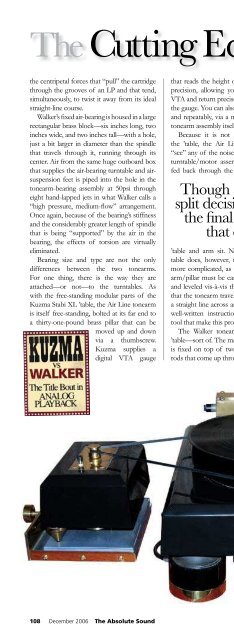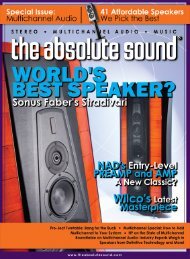You also want an ePaper? Increase the reach of your titles
YUMPU automatically turns print PDFs into web optimized ePapers that Google loves.
The Cutting Edge<br />
the centripetal forces that “pull” the cartridge<br />
through the grooves of an LP and that tend,<br />
simultaneously, to twist it away from its ideal<br />
straight-line course.<br />
Walker’s fixed air-bearing is housed in a large<br />
rectangular brass block—six inches long, two<br />
inches wide, and two inches tall—with a hole,<br />
just a bit larger in diameter than the spindle<br />
that travels through it, running through its<br />
center. Air from the same huge outboard box<br />
that supplies the air-bearing turntable and airsuspension<br />
feet is piped into the hole in the<br />
tonearm-bearing assembly at 50psi through<br />
eight hand-lapped jets in what Walker calls a<br />
“high pressure, medium-flow” arrangement.<br />
Once again, because of the bearing’s stiffness<br />
and the considerably greater length of spindle<br />
that is being “supported” by the air in the<br />
bearing, the effects of torsion are virtually<br />
eliminated.<br />
Bearing size and type are not the only<br />
differences between the two tonearms.<br />
For one thing, there is the way they are<br />
attached—or not—to the turntables. As<br />
with the free-standing modular parts of the<br />
Kuzma Stabi XL ’table, the Air Line tonearm<br />
is itself free-standing, bolted at its far end to<br />
a thirty-one-pound brass pillar that can be<br />
moved up and down<br />
via a thumbscrew.<br />
Kuzma supplies a<br />
digital VTA gauge<br />
that reads the height of the pillar with great<br />
precision, allowing you to experiment with<br />
VTA and return precisely to the same spot on<br />
the gauge. You can also adjust VTA, precisely<br />
and repeatably, via a numbered knob on the<br />
tonearm assembly itself.<br />
Because it is not physically attached to<br />
the ’table, the Air Line tonearm does not<br />
“see” any of the noises or resonances of the<br />
turntable/motor assembly, save as they are<br />
fed back through the stand on which both<br />
Though a bit of a<br />
split decision, to me<br />
the final call isn’t<br />
that close<br />
’table and arm sit. Not being fixed to the<br />
table does, however, make arm setup a bit<br />
more complicated, as the entire freestanding<br />
arm/pillar must be carefully moved, rotated,<br />
and leveled vis-à-vis the platter to make sure<br />
that the tonearm travels at the right height in<br />
a straight line across an LP. (Kuzma supplies<br />
well-written instructions and an alignment<br />
tool that make this process a snap.)<br />
The Walker tonearm is attached to the<br />
’table—sort of. The massive air-bearing block<br />
is fixed on top of two sizeable carbon-fiber<br />
rods that come up through holes in the plinth.<br />
Although the rods are bolted on their bottom<br />
to the plinth’s base, you have to wonder how<br />
much vibration the tonearm might see, given<br />
its own material composition, the mass of<br />
the air bearing and plinth, and the facts that<br />
both tonearm/spindle and platter ride on<br />
air and that the motor is physically isolated<br />
from the ’table. Although not as cool or<br />
convenient as the Kuzma in this regard, the<br />
Walker arm also allows precise repeatability of<br />
VTA adjustments via two knurled knobs on<br />
the tonearm pillar, and because the Walker’s<br />
bearing assembly and arm are fixed in relation<br />
to the platter, arm/cartridge alignment is<br />
somewhat easier.<br />
Another significant difference between the<br />
Kuzma and Walker is the material composition<br />
of their tonearms. The Kuzma uses a stiff,<br />
hollow, conical tube—beautifully machined<br />
from three solid blocks of aluminum and<br />
damped internally—that is welded to the<br />
traveling air bearing. Air is fed to a nipple<br />
on the bearing via flexible tubing that runs<br />
between it and a valve at the supported end of<br />
the tonearm assembly. (A nifty little gauge at<br />
the free end of the tonearm assembly tells you<br />
how much air pressure you’re running through<br />
the bearing.) Air is supplied to the bearing by<br />
a regulated, oil-lubricated, industrial-grade<br />
compressor that filters for dust and moisture.<br />
Because of the occasional loud “spitting”<br />
noises it makes during its duty cycle, the<br />
108 December 2006 The Absolute Sound










